Whether bird watchers are enjoying birds from their backyards or out in the field, many individuals are faced with the question, is that a hairy or downy woodpecker? These two species are quite common, year-round visitors in North America and once you know what to look for, it is not as difficult as one would think to tell the difference between the two. While I was taking an ornithology course in college, we were taught to distinguish between the two species, by overall size and beak description. Although these two points of identification are a good place to start, sometimes they just aren’t enough. In this post, I would like to discuss further ways to help us determine the difference between these two species of woodpeckers.
Size & Shape
The hairy woodpecker Leuconotopicus villosus is a medium-sized bird and about the same size as a robin (9.25″ long). These woodpeckers are about 1/3 longer than the downy woodpecker and weigh almost three times as much. In comparison, the downy woodpecker Picoides pubescens, is a small woodpecker, about the size of a house sparrow (about 6.5″ long). It can still be difficult to distinguish between the two species unless they are side by side. For further investigation, we will look at bill size.
Bill Size
The hairy woodpecker has a long and strong chisel-like beak that is almost the same size as its head. The bill of the downy woodpecker is a short and small needle-like beak and dainty in comparison, about 1/3 the length of the bird’s head. While observing the two types of woodpeckers, make sure to take notice of these bill characteristics and this will help in your identifying which type of woodpecker you are looking at. The male and female of each species are roughly the same sizes, so if you are looking at two types of woodpeckers of different sizes, the larger is most likely to be a hairy and the smaller is a downy woodpecker. Now that we can gauge overall size and bill size, you are closer to telling the difference between the two species. To further our identification skills, let us explore color patterns.
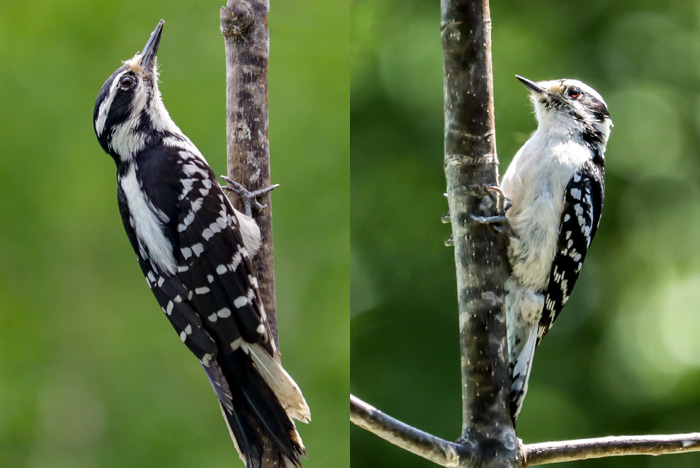
A female hairy woodpecker on the left and a female downy woodpecker on the right. Notice how much larger the hairy woodpecker’s bill looks than the downy’s.
Color Patterns
Both species are black and white in color and the wings are checkered with white. In most of the Eastern United States, hairy woodpeckers will have all-white outer tail feathers. In the Pacific and Newfoundland, black bars can be found on the outer tail feathers. The head has two white stripes and there is a white patch that runs down the center of a black back. Males have a red patch that is often split, toward the back of the head. Downy woodpeckers, on the other hand, have outer tail feathers that are white with black bars, giving them a spotted effect. The head is boldly striped and the back has a broad white stripe down the center. Males have a small red patch on the back of the head.
Another color pattern aiding in identification pertains to the “comma mark.” The hairy woodpecker has a distinct, well-developed “comma-shaped” black mark that extends from the shoulder onto the breast. The downy’s mark is often less obvious, but can sometimes be a useful distinguishing mark.
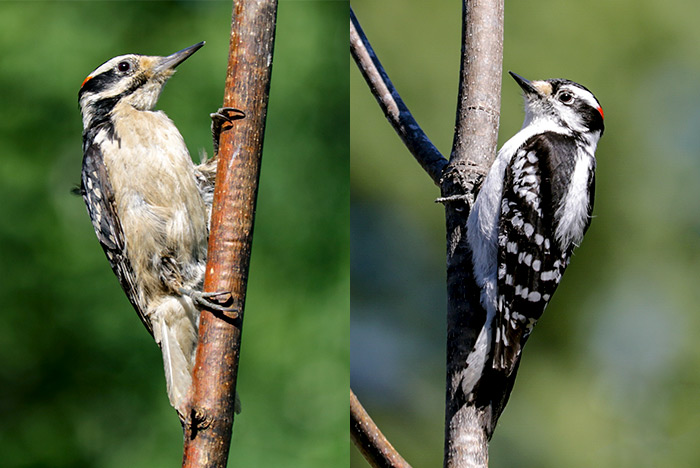
A male hairy woodpecker on the left and a male downy woodpecker on the right.
While observing these birds, it is also important to take note of fledglings, in order to minimize further confusion. As the males of both of these species have red coloring on the backs of their heads, fledglings will have red on the top of their heads. Young hairy woodpeckers will sometimes have a yellow patch. Young birds can have extra black marks or white stripes as well. You can probably get a better picture by identifying which species you are observing, while at nesting sites or when these birds are visiting your feeders.
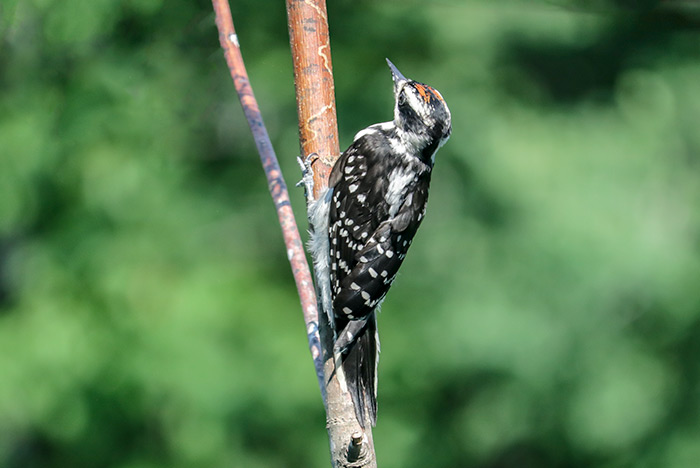
Take notice of the red marking on the top of this juvenile male hairy woodpecker’s head.
Behavior
Hairy and downy woodpeckers share most of the same habitats. Although, hairy woodpeckers prefer mature woods with large trees and abundant insects. They will typically move up tree trunks or along large branches while leaning back against their stiff tail feathers and springing upward with both feet at the same time. You can find downy woodpeckers in open woodlands, particularly with deciduous trees. They move quickly over tree trunks, and branches, leaning with stiffened tail feathers for support. Downy woodpeckers move horizontally and downwards on trees with more ease than most other woodpeckers.
Voice and Sound
Both of these species have short, sharp calls. However, if you listen carefully, you can hear the slight differences in their calls. Hairy woodpeckers have a contact call that is a short and sharp peek or peech sound. When agitated, this is described as being a stuttering peek sound. They also have a sharp rattle that stays at one pitch, described as a rapid high kweek sound. The downy woodpecker contact call is a short, gentle flat pik sound that starts out in a rapid string of high-pitched notes that descend in pitch toward the end.
Also, listen for different drumming sounds. The males and females of both species will use their bills to drum on trees as a way of communicating. The hairy woodpecker’s drum sound is a very fast buzzing and usually slows down toward the end. The downy’s drum is slightly slower than that of the hairy, about nine to sixteen beats per minute.
When I put my feeders out in the morning, I usually hear the short calls of the hairy woodpeckers. The same female has been frequenting my feeders every season for a couple of years now and she sure lets me know when she is hungry. While I’m hanging the feeders, she can hardly wait. I have lost count of how many times I have felt the wind on me, from her wings beating on her way to the feeders. Next, this will bring me to what these two species of woodpeckers eat.
Food Sources and Feeders
The majority of the hairy woodpecker’s diet is mainly made up of insects, such as the larvae of wood-boring beetles, bark beetles, moths pupae, and ants. They also eat bees, wasps, caterpillars, spiders, millipedes, and in some cases, cockroaches, crickets, and grasshoppers. Downy woodpeckers also eat mainly insects, including beetle larvae that are found inside wood or tree bark as well as insects such as ants and caterpillars. They eat pest insects such as tent caterpillars, bark beetles, corn earworms, and apple borers. About 1/4th of their diet consists of plant material, such as berries, acorns, and grains.
Both species of woodpeckers are common visitors to bird feeders, eating suet and sunflower seeds. I have had many of these two species come to my feeders and I have had a lot of success and happy bird customers coming back with C & S suet cakes and Feathered Friends premium black oil sunflower seeds. My woodpecker visitors have been enjoying, in particular, the orange, cherry, and berry-flavored suet cakes this season from C & S.
It is a good idea to set up a few types of feeders and experiment with different brands and flavors of suet as well as different brands of sunflower seeds to help you figure out what your woodpecker visitors will enjoy best. These two types of foods are excellent sources of fats and proteins for energy. This will aid in their survival during the harsh winter months and the breeding season for exhausted parents to feed themselves and their offspring. The good spacing of feeders is also beneficial for decreasing the chances of spreading diseases and make sure to clean your feeders frequently. Also, I always think the more feeders the better, because of competition with other bird species. Hairy woodpeckers can be quite aggressive at feeders and this may deter the smaller birds from coming to feed. This will bring me to my next point in making sure you are identifying these species correctly using a few tools and resources.
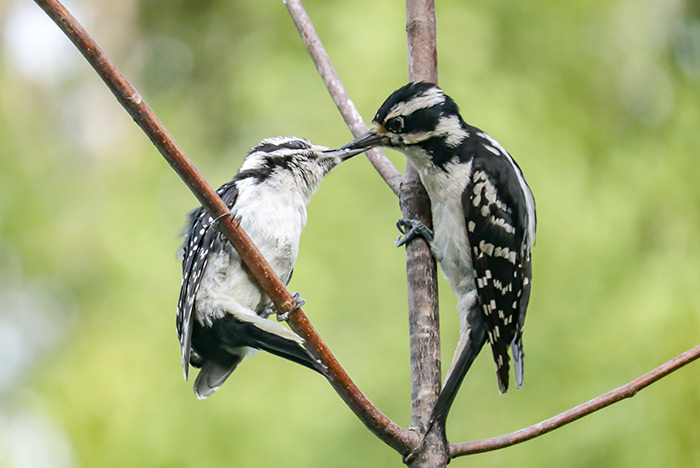
A female hairy woodpecker feeding suet to her young.
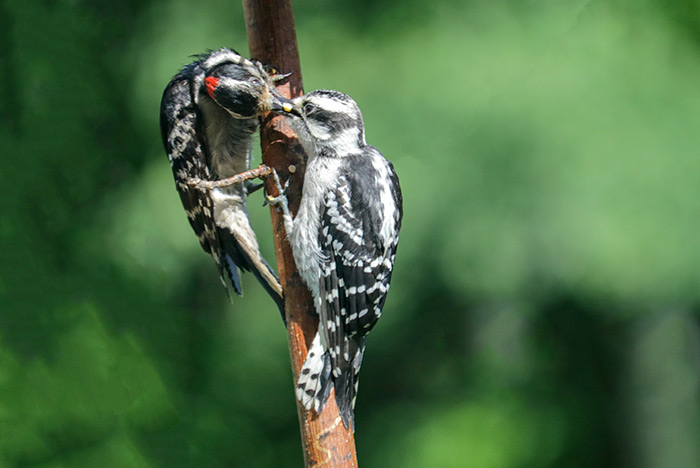
A male downy woodpecker feeding suet to his offspring.
Tools and Resources
Now that you have both species of woodpeckers coming to your feeders, I would recommend taking photographs of the two species for comparison. There is also the free Merlin Bird ID App for instant bird identification. If you like to do things the old-school way, like me, you can observe your photographs and consult field guides for proper identification or do internet research as well. I am always referring to books for help and doing research on The Cornell Lab of Ornithology All About Birds. For more resources, you can also check out my resource page. For the field, I would also recommend taking photographs, a good pair of lightweight binoculars, and field guides.
If you look for these key points as I have discussed to identify the difference between the hairy and downy woodpecker, you should have great success. I hope these points have helped you and remember to listen, as well as observe. Happy birding!
Resources used for this post:
allaboutbirds.org, audubon.org & The Sibley Guide to Birds
Leave a Reply